Analysis of spoken English language and Corpus Linguistics
VerifiedAdded on 2022/08/26
|13
|4323
|60
AI Summary
Contribute Materials
Your contribution can guide someone’s learning journey. Share your
documents today.
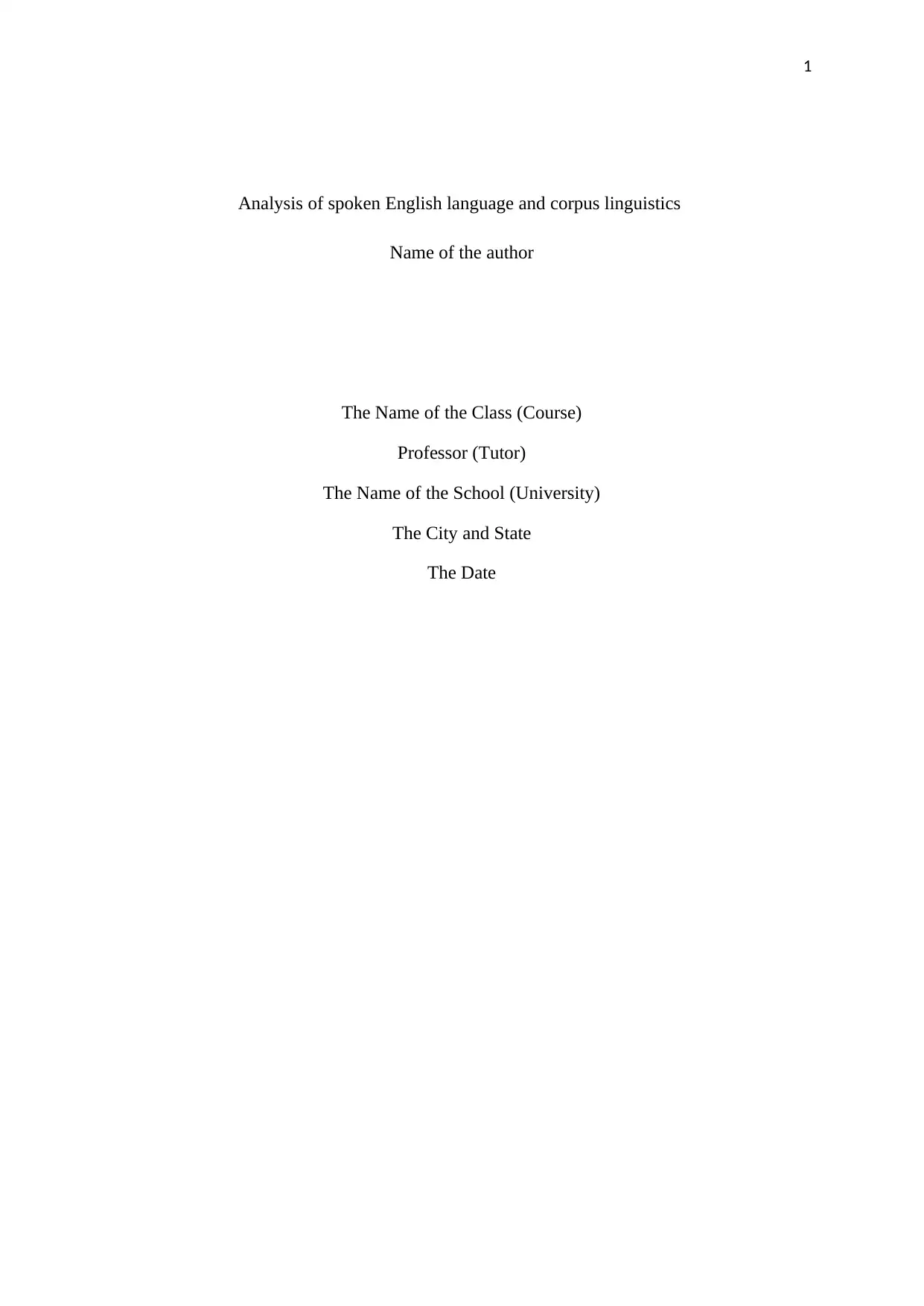
1
Analysis of spoken English language and corpus linguistics
Name of the author
The Name of the Class (Course)
Professor (Tutor)
The Name of the School (University)
The City and State
The Date
Analysis of spoken English language and corpus linguistics
Name of the author
The Name of the Class (Course)
Professor (Tutor)
The Name of the School (University)
The City and State
The Date
Secure Best Marks with AI Grader
Need help grading? Try our AI Grader for instant feedback on your assignments.
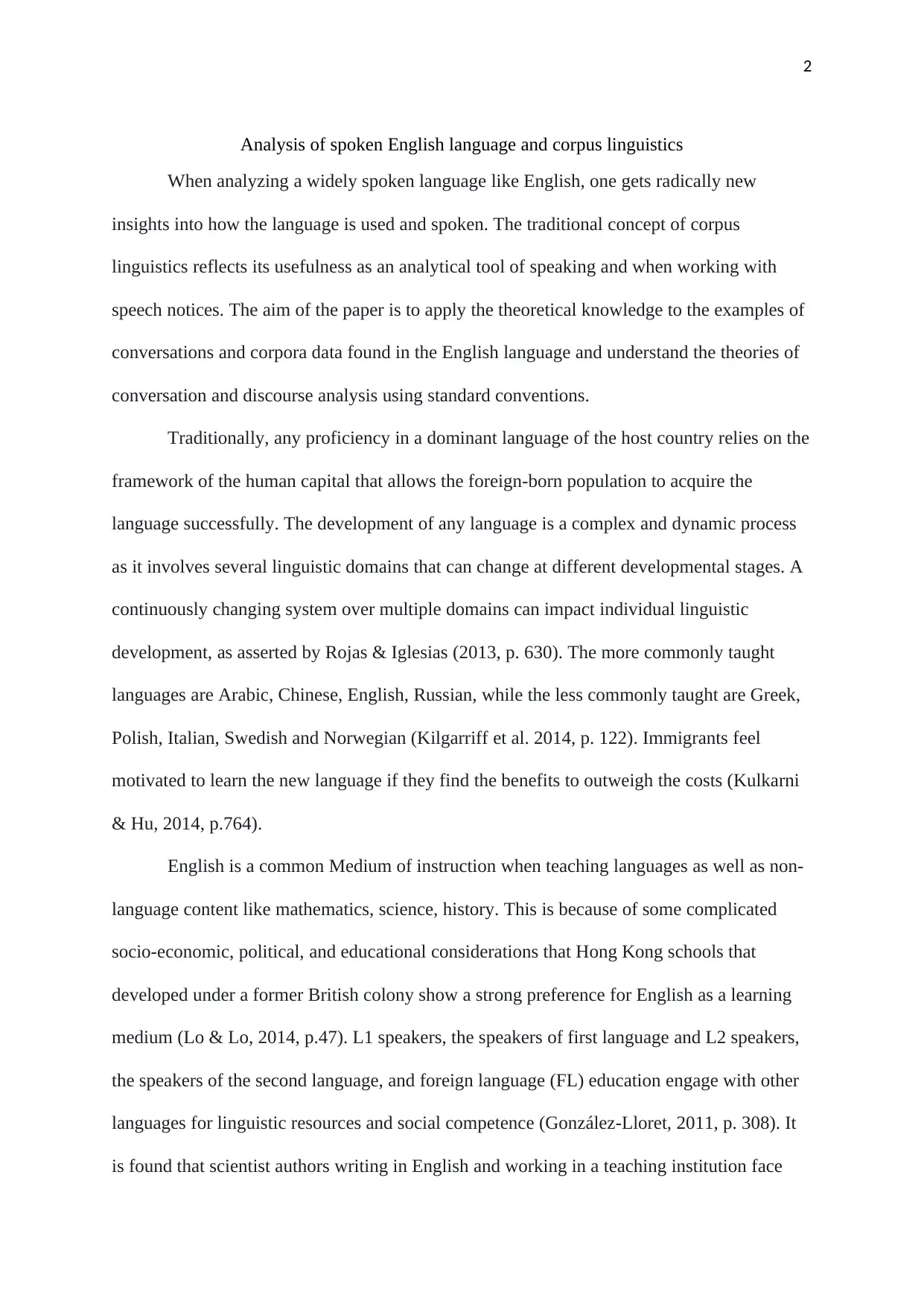
2
Analysis of spoken English language and corpus linguistics
When analyzing a widely spoken language like English, one gets radically new
insights into how the language is used and spoken. The traditional concept of corpus
linguistics reflects its usefulness as an analytical tool of speaking and when working with
speech notices. The aim of the paper is to apply the theoretical knowledge to the examples of
conversations and corpora data found in the English language and understand the theories of
conversation and discourse analysis using standard conventions.
Traditionally, any proficiency in a dominant language of the host country relies on the
framework of the human capital that allows the foreign-born population to acquire the
language successfully. The development of any language is a complex and dynamic process
as it involves several linguistic domains that can change at different developmental stages. A
continuously changing system over multiple domains can impact individual linguistic
development, as asserted by Rojas & Iglesias (2013, p. 630). The more commonly taught
languages are Arabic, Chinese, English, Russian, while the less commonly taught are Greek,
Polish, Italian, Swedish and Norwegian (Kilgarriff et al. 2014, p. 122). Immigrants feel
motivated to learn the new language if they find the benefits to outweigh the costs (Kulkarni
& Hu, 2014, p.764).
English is a common Medium of instruction when teaching languages as well as non-
language content like mathematics, science, history. This is because of some complicated
socio-economic, political, and educational considerations that Hong Kong schools that
developed under a former British colony show a strong preference for English as a learning
medium (Lo & Lo, 2014, p.47). L1 speakers, the speakers of first language and L2 speakers,
the speakers of the second language, and foreign language (FL) education engage with other
languages for linguistic resources and social competence (González-Lloret, 2011, p. 308). It
is found that scientist authors writing in English and working in a teaching institution face
Analysis of spoken English language and corpus linguistics
When analyzing a widely spoken language like English, one gets radically new
insights into how the language is used and spoken. The traditional concept of corpus
linguistics reflects its usefulness as an analytical tool of speaking and when working with
speech notices. The aim of the paper is to apply the theoretical knowledge to the examples of
conversations and corpora data found in the English language and understand the theories of
conversation and discourse analysis using standard conventions.
Traditionally, any proficiency in a dominant language of the host country relies on the
framework of the human capital that allows the foreign-born population to acquire the
language successfully. The development of any language is a complex and dynamic process
as it involves several linguistic domains that can change at different developmental stages. A
continuously changing system over multiple domains can impact individual linguistic
development, as asserted by Rojas & Iglesias (2013, p. 630). The more commonly taught
languages are Arabic, Chinese, English, Russian, while the less commonly taught are Greek,
Polish, Italian, Swedish and Norwegian (Kilgarriff et al. 2014, p. 122). Immigrants feel
motivated to learn the new language if they find the benefits to outweigh the costs (Kulkarni
& Hu, 2014, p.764).
English is a common Medium of instruction when teaching languages as well as non-
language content like mathematics, science, history. This is because of some complicated
socio-economic, political, and educational considerations that Hong Kong schools that
developed under a former British colony show a strong preference for English as a learning
medium (Lo & Lo, 2014, p.47). L1 speakers, the speakers of first language and L2 speakers,
the speakers of the second language, and foreign language (FL) education engage with other
languages for linguistic resources and social competence (González-Lloret, 2011, p. 308). It
is found that scientist authors writing in English and working in a teaching institution face
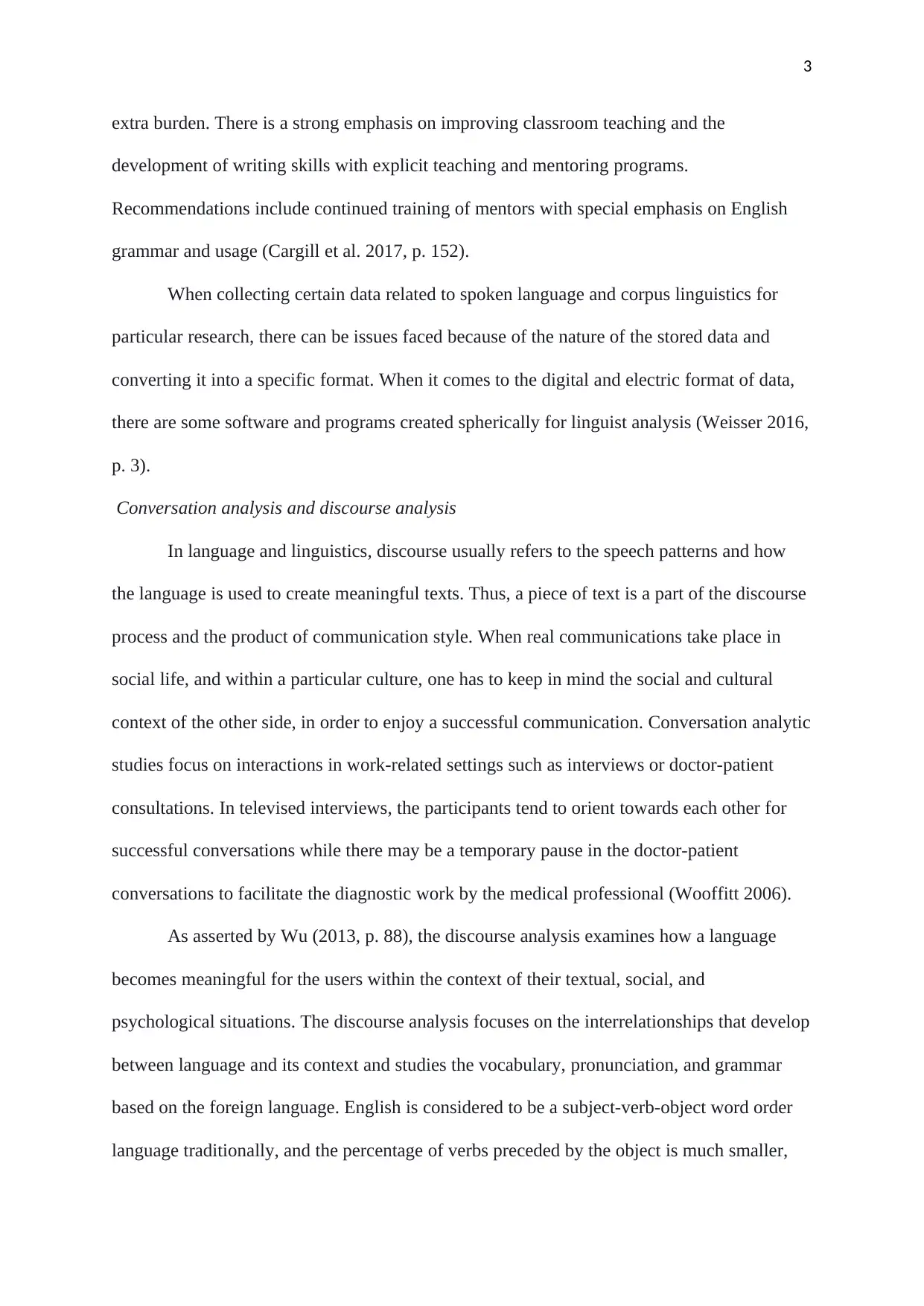
3
extra burden. There is a strong emphasis on improving classroom teaching and the
development of writing skills with explicit teaching and mentoring programs.
Recommendations include continued training of mentors with special emphasis on English
grammar and usage (Cargill et al. 2017, p. 152).
When collecting certain data related to spoken language and corpus linguistics for
particular research, there can be issues faced because of the nature of the stored data and
converting it into a specific format. When it comes to the digital and electric format of data,
there are some software and programs created spherically for linguist analysis (Weisser 2016,
p. 3).
Conversation analysis and discourse analysis
In language and linguistics, discourse usually refers to the speech patterns and how
the language is used to create meaningful texts. Thus, a piece of text is a part of the discourse
process and the product of communication style. When real communications take place in
social life, and within a particular culture, one has to keep in mind the social and cultural
context of the other side, in order to enjoy a successful communication. Conversation analytic
studies focus on interactions in work-related settings such as interviews or doctor-patient
consultations. In televised interviews, the participants tend to orient towards each other for
successful conversations while there may be a temporary pause in the doctor-patient
conversations to facilitate the diagnostic work by the medical professional (Wooffitt 2006).
As asserted by Wu (2013, p. 88), the discourse analysis examines how a language
becomes meaningful for the users within the context of their textual, social, and
psychological situations. The discourse analysis focuses on the interrelationships that develop
between language and its context and studies the vocabulary, pronunciation, and grammar
based on the foreign language. English is considered to be a subject-verb-object word order
language traditionally, and the percentage of verbs preceded by the object is much smaller,
extra burden. There is a strong emphasis on improving classroom teaching and the
development of writing skills with explicit teaching and mentoring programs.
Recommendations include continued training of mentors with special emphasis on English
grammar and usage (Cargill et al. 2017, p. 152).
When collecting certain data related to spoken language and corpus linguistics for
particular research, there can be issues faced because of the nature of the stored data and
converting it into a specific format. When it comes to the digital and electric format of data,
there are some software and programs created spherically for linguist analysis (Weisser 2016,
p. 3).
Conversation analysis and discourse analysis
In language and linguistics, discourse usually refers to the speech patterns and how
the language is used to create meaningful texts. Thus, a piece of text is a part of the discourse
process and the product of communication style. When real communications take place in
social life, and within a particular culture, one has to keep in mind the social and cultural
context of the other side, in order to enjoy a successful communication. Conversation analytic
studies focus on interactions in work-related settings such as interviews or doctor-patient
consultations. In televised interviews, the participants tend to orient towards each other for
successful conversations while there may be a temporary pause in the doctor-patient
conversations to facilitate the diagnostic work by the medical professional (Wooffitt 2006).
As asserted by Wu (2013, p. 88), the discourse analysis examines how a language
becomes meaningful for the users within the context of their textual, social, and
psychological situations. The discourse analysis focuses on the interrelationships that develop
between language and its context and studies the vocabulary, pronunciation, and grammar
based on the foreign language. English is considered to be a subject-verb-object word order
language traditionally, and the percentage of verbs preceded by the object is much smaller,
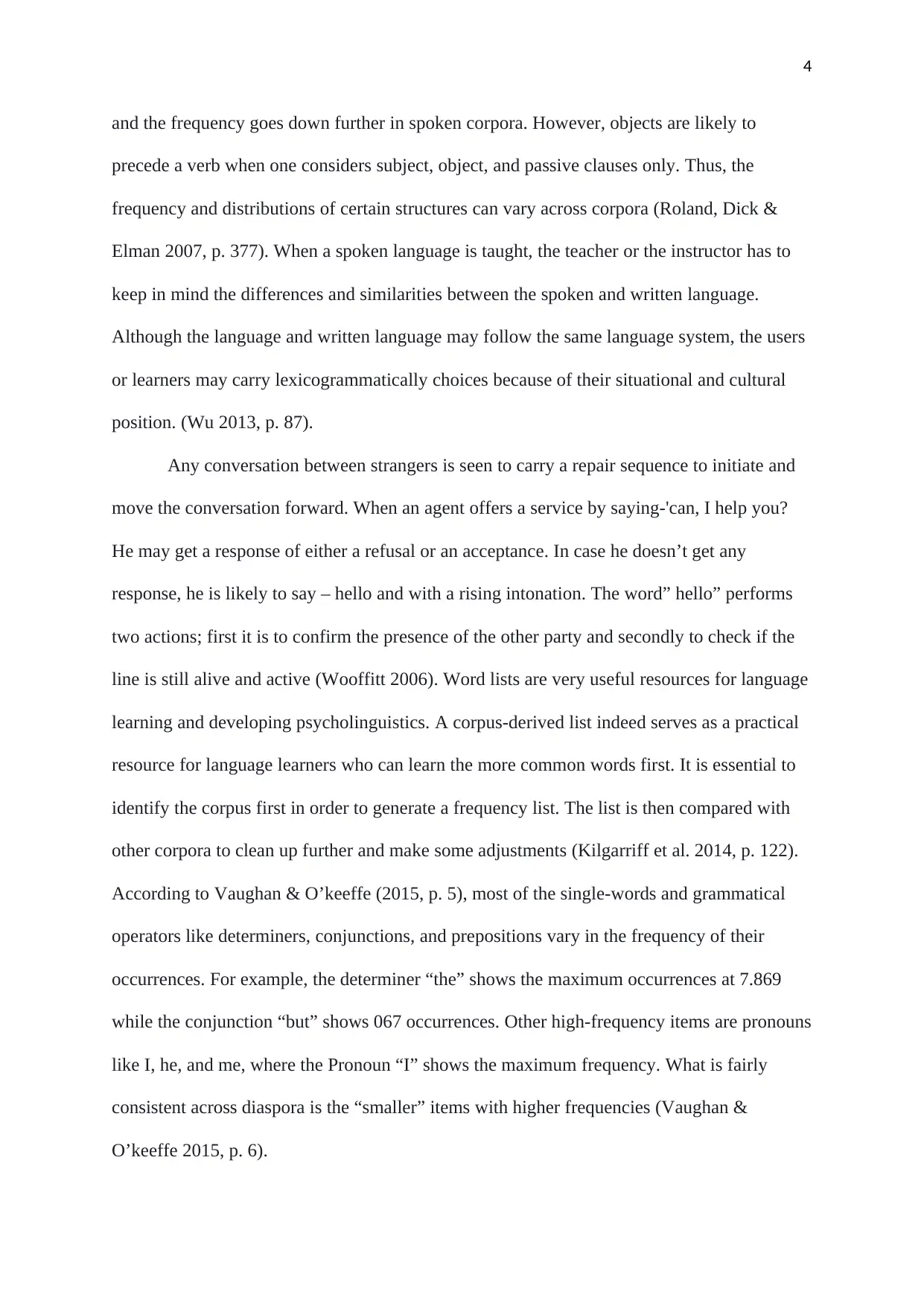
4
and the frequency goes down further in spoken corpora. However, objects are likely to
precede a verb when one considers subject, object, and passive clauses only. Thus, the
frequency and distributions of certain structures can vary across corpora (Roland, Dick &
Elman 2007, p. 377). When a spoken language is taught, the teacher or the instructor has to
keep in mind the differences and similarities between the spoken and written language.
Although the language and written language may follow the same language system, the users
or learners may carry lexicogrammatically choices because of their situational and cultural
position. (Wu 2013, p. 87).
Any conversation between strangers is seen to carry a repair sequence to initiate and
move the conversation forward. When an agent offers a service by saying-'can, I help you?
He may get a response of either a refusal or an acceptance. In case he doesn’t get any
response, he is likely to say – hello and with a rising intonation. The word” hello” performs
two actions; first it is to confirm the presence of the other party and secondly to check if the
line is still alive and active (Wooffitt 2006). Word lists are very useful resources for language
learning and developing psycholinguistics. A corpus-derived list indeed serves as a practical
resource for language learners who can learn the more common words first. It is essential to
identify the corpus first in order to generate a frequency list. The list is then compared with
other corpora to clean up further and make some adjustments (Kilgarriff et al. 2014, p. 122).
According to Vaughan & O’keeffe (2015, p. 5), most of the single-words and grammatical
operators like determiners, conjunctions, and prepositions vary in the frequency of their
occurrences. For example, the determiner “the” shows the maximum occurrences at 7.869
while the conjunction “but” shows 067 occurrences. Other high-frequency items are pronouns
like I, he, and me, where the Pronoun “I” shows the maximum frequency. What is fairly
consistent across diaspora is the “smaller” items with higher frequencies (Vaughan &
O’keeffe 2015, p. 6).
and the frequency goes down further in spoken corpora. However, objects are likely to
precede a verb when one considers subject, object, and passive clauses only. Thus, the
frequency and distributions of certain structures can vary across corpora (Roland, Dick &
Elman 2007, p. 377). When a spoken language is taught, the teacher or the instructor has to
keep in mind the differences and similarities between the spoken and written language.
Although the language and written language may follow the same language system, the users
or learners may carry lexicogrammatically choices because of their situational and cultural
position. (Wu 2013, p. 87).
Any conversation between strangers is seen to carry a repair sequence to initiate and
move the conversation forward. When an agent offers a service by saying-'can, I help you?
He may get a response of either a refusal or an acceptance. In case he doesn’t get any
response, he is likely to say – hello and with a rising intonation. The word” hello” performs
two actions; first it is to confirm the presence of the other party and secondly to check if the
line is still alive and active (Wooffitt 2006). Word lists are very useful resources for language
learning and developing psycholinguistics. A corpus-derived list indeed serves as a practical
resource for language learners who can learn the more common words first. It is essential to
identify the corpus first in order to generate a frequency list. The list is then compared with
other corpora to clean up further and make some adjustments (Kilgarriff et al. 2014, p. 122).
According to Vaughan & O’keeffe (2015, p. 5), most of the single-words and grammatical
operators like determiners, conjunctions, and prepositions vary in the frequency of their
occurrences. For example, the determiner “the” shows the maximum occurrences at 7.869
while the conjunction “but” shows 067 occurrences. Other high-frequency items are pronouns
like I, he, and me, where the Pronoun “I” shows the maximum frequency. What is fairly
consistent across diaspora is the “smaller” items with higher frequencies (Vaughan &
O’keeffe 2015, p. 6).
Secure Best Marks with AI Grader
Need help grading? Try our AI Grader for instant feedback on your assignments.
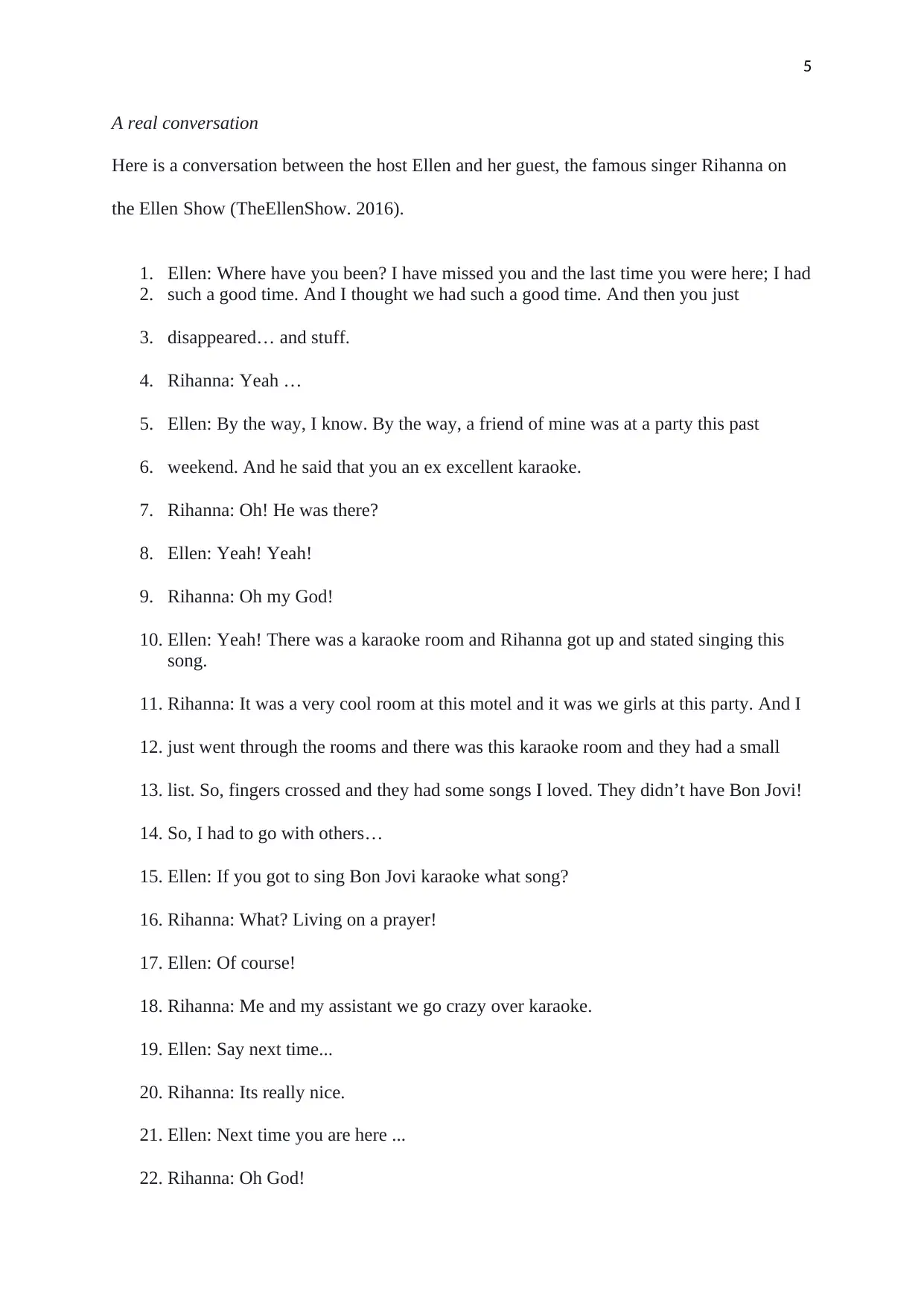
5
A real conversation
Here is a conversation between the host Ellen and her guest, the famous singer Rihanna on
the Ellen Show (TheEllenShow. 2016).
1. Ellen: Where have you been? I have missed you and the last time you were here; I had
2. such a good time. And I thought we had such a good time. And then you just
3. disappeared… and stuff.
4. Rihanna: Yeah …
5. Ellen: By the way, I know. By the way, a friend of mine was at a party this past
6. weekend. And he said that you an ex excellent karaoke.
7. Rihanna: Oh! He was there?
8. Ellen: Yeah! Yeah!
9. Rihanna: Oh my God!
10. Ellen: Yeah! There was a karaoke room and Rihanna got up and stated singing this
song.
11. Rihanna: It was a very cool room at this motel and it was we girls at this party. And I
12. just went through the rooms and there was this karaoke room and they had a small
13. list. So, fingers crossed and they had some songs I loved. They didn’t have Bon Jovi!
14. So, I had to go with others…
15. Ellen: If you got to sing Bon Jovi karaoke what song?
16. Rihanna: What? Living on a prayer!
17. Ellen: Of course!
18. Rihanna: Me and my assistant we go crazy over karaoke.
19. Ellen: Say next time...
20. Rihanna: Its really nice.
21. Ellen: Next time you are here ...
22. Rihanna: Oh God!
A real conversation
Here is a conversation between the host Ellen and her guest, the famous singer Rihanna on
the Ellen Show (TheEllenShow. 2016).
1. Ellen: Where have you been? I have missed you and the last time you were here; I had
2. such a good time. And I thought we had such a good time. And then you just
3. disappeared… and stuff.
4. Rihanna: Yeah …
5. Ellen: By the way, I know. By the way, a friend of mine was at a party this past
6. weekend. And he said that you an ex excellent karaoke.
7. Rihanna: Oh! He was there?
8. Ellen: Yeah! Yeah!
9. Rihanna: Oh my God!
10. Ellen: Yeah! There was a karaoke room and Rihanna got up and stated singing this
song.
11. Rihanna: It was a very cool room at this motel and it was we girls at this party. And I
12. just went through the rooms and there was this karaoke room and they had a small
13. list. So, fingers crossed and they had some songs I loved. They didn’t have Bon Jovi!
14. So, I had to go with others…
15. Ellen: If you got to sing Bon Jovi karaoke what song?
16. Rihanna: What? Living on a prayer!
17. Ellen: Of course!
18. Rihanna: Me and my assistant we go crazy over karaoke.
19. Ellen: Say next time...
20. Rihanna: Its really nice.
21. Ellen: Next time you are here ...
22. Rihanna: Oh God!
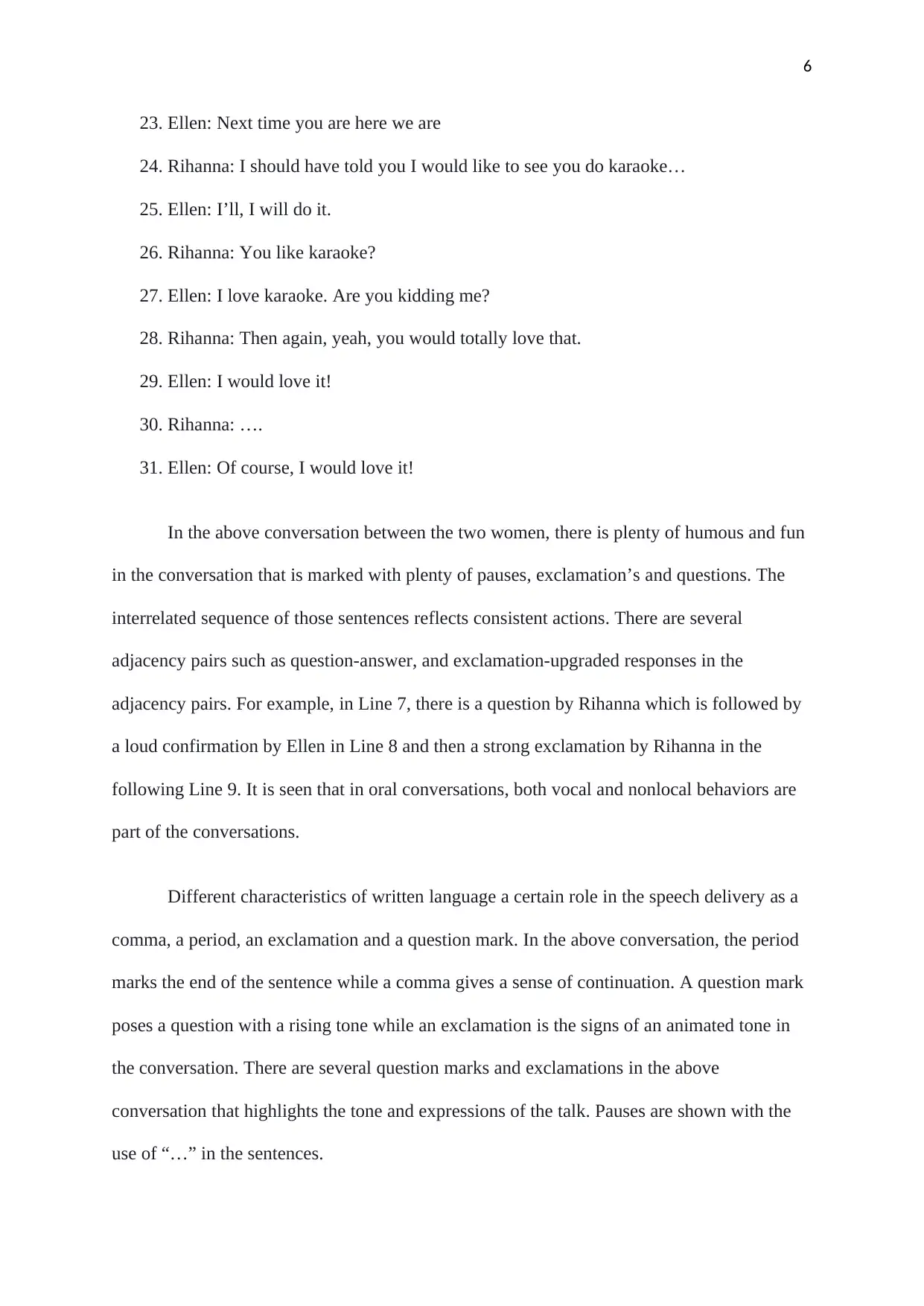
6
23. Ellen: Next time you are here we are
24. Rihanna: I should have told you I would like to see you do karaoke…
25. Ellen: I’ll, I will do it.
26. Rihanna: You like karaoke?
27. Ellen: I love karaoke. Are you kidding me?
28. Rihanna: Then again, yeah, you would totally love that.
29. Ellen: I would love it!
30. Rihanna: ….
31. Ellen: Of course, I would love it!
In the above conversation between the two women, there is plenty of humous and fun
in the conversation that is marked with plenty of pauses, exclamation’s and questions. The
interrelated sequence of those sentences reflects consistent actions. There are several
adjacency pairs such as question-answer, and exclamation-upgraded responses in the
adjacency pairs. For example, in Line 7, there is a question by Rihanna which is followed by
a loud confirmation by Ellen in Line 8 and then a strong exclamation by Rihanna in the
following Line 9. It is seen that in oral conversations, both vocal and nonlocal behaviors are
part of the conversations.
Different characteristics of written language a certain role in the speech delivery as a
comma, a period, an exclamation and a question mark. In the above conversation, the period
marks the end of the sentence while a comma gives a sense of continuation. A question mark
poses a question with a rising tone while an exclamation is the signs of an animated tone in
the conversation. There are several question marks and exclamations in the above
conversation that highlights the tone and expressions of the talk. Pauses are shown with the
use of “…” in the sentences.
23. Ellen: Next time you are here we are
24. Rihanna: I should have told you I would like to see you do karaoke…
25. Ellen: I’ll, I will do it.
26. Rihanna: You like karaoke?
27. Ellen: I love karaoke. Are you kidding me?
28. Rihanna: Then again, yeah, you would totally love that.
29. Ellen: I would love it!
30. Rihanna: ….
31. Ellen: Of course, I would love it!
In the above conversation between the two women, there is plenty of humous and fun
in the conversation that is marked with plenty of pauses, exclamation’s and questions. The
interrelated sequence of those sentences reflects consistent actions. There are several
adjacency pairs such as question-answer, and exclamation-upgraded responses in the
adjacency pairs. For example, in Line 7, there is a question by Rihanna which is followed by
a loud confirmation by Ellen in Line 8 and then a strong exclamation by Rihanna in the
following Line 9. It is seen that in oral conversations, both vocal and nonlocal behaviors are
part of the conversations.
Different characteristics of written language a certain role in the speech delivery as a
comma, a period, an exclamation and a question mark. In the above conversation, the period
marks the end of the sentence while a comma gives a sense of continuation. A question mark
poses a question with a rising tone while an exclamation is the signs of an animated tone in
the conversation. There are several question marks and exclamations in the above
conversation that highlights the tone and expressions of the talk. Pauses are shown with the
use of “…” in the sentences.
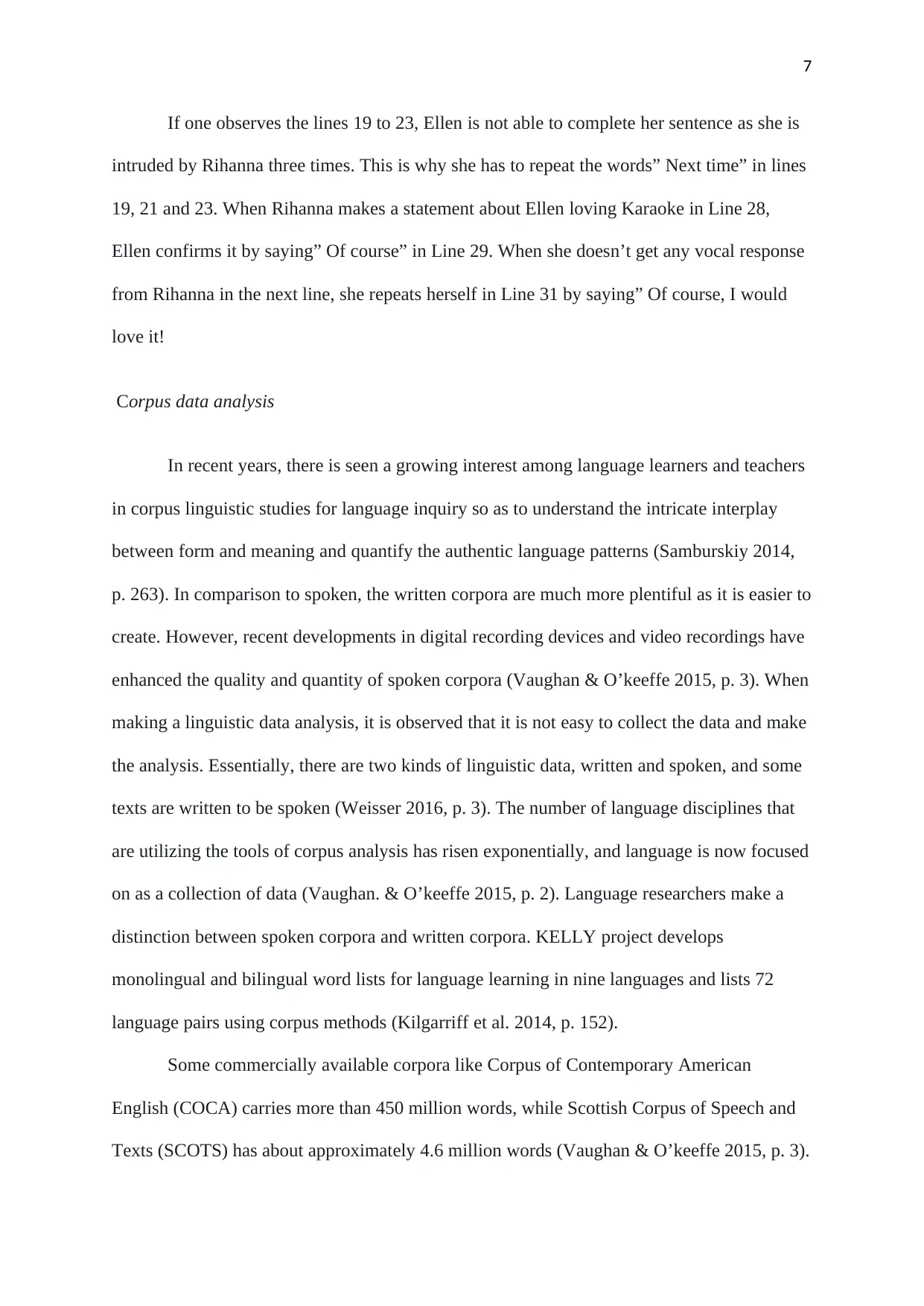
7
If one observes the lines 19 to 23, Ellen is not able to complete her sentence as she is
intruded by Rihanna three times. This is why she has to repeat the words” Next time” in lines
19, 21 and 23. When Rihanna makes a statement about Ellen loving Karaoke in Line 28,
Ellen confirms it by saying” Of course” in Line 29. When she doesn’t get any vocal response
from Rihanna in the next line, she repeats herself in Line 31 by saying” Of course, I would
love it!
Corpus data analysis
In recent years, there is seen a growing interest among language learners and teachers
in corpus linguistic studies for language inquiry so as to understand the intricate interplay
between form and meaning and quantify the authentic language patterns (Samburskiy 2014,
p. 263). In comparison to spoken, the written corpora are much more plentiful as it is easier to
create. However, recent developments in digital recording devices and video recordings have
enhanced the quality and quantity of spoken corpora (Vaughan & O’keeffe 2015, p. 3). When
making a linguistic data analysis, it is observed that it is not easy to collect the data and make
the analysis. Essentially, there are two kinds of linguistic data, written and spoken, and some
texts are written to be spoken (Weisser 2016, p. 3). The number of language disciplines that
are utilizing the tools of corpus analysis has risen exponentially, and language is now focused
on as a collection of data (Vaughan. & O’keeffe 2015, p. 2). Language researchers make a
distinction between spoken corpora and written corpora. KELLY project develops
monolingual and bilingual word lists for language learning in nine languages and lists 72
language pairs using corpus methods (Kilgarriff et al. 2014, p. 152).
Some commercially available corpora like Corpus of Contemporary American
English (COCA) carries more than 450 million words, while Scottish Corpus of Speech and
Texts (SCOTS) has about approximately 4.6 million words (Vaughan & O’keeffe 2015, p. 3).
If one observes the lines 19 to 23, Ellen is not able to complete her sentence as she is
intruded by Rihanna three times. This is why she has to repeat the words” Next time” in lines
19, 21 and 23. When Rihanna makes a statement about Ellen loving Karaoke in Line 28,
Ellen confirms it by saying” Of course” in Line 29. When she doesn’t get any vocal response
from Rihanna in the next line, she repeats herself in Line 31 by saying” Of course, I would
love it!
Corpus data analysis
In recent years, there is seen a growing interest among language learners and teachers
in corpus linguistic studies for language inquiry so as to understand the intricate interplay
between form and meaning and quantify the authentic language patterns (Samburskiy 2014,
p. 263). In comparison to spoken, the written corpora are much more plentiful as it is easier to
create. However, recent developments in digital recording devices and video recordings have
enhanced the quality and quantity of spoken corpora (Vaughan & O’keeffe 2015, p. 3). When
making a linguistic data analysis, it is observed that it is not easy to collect the data and make
the analysis. Essentially, there are two kinds of linguistic data, written and spoken, and some
texts are written to be spoken (Weisser 2016, p. 3). The number of language disciplines that
are utilizing the tools of corpus analysis has risen exponentially, and language is now focused
on as a collection of data (Vaughan. & O’keeffe 2015, p. 2). Language researchers make a
distinction between spoken corpora and written corpora. KELLY project develops
monolingual and bilingual word lists for language learning in nine languages and lists 72
language pairs using corpus methods (Kilgarriff et al. 2014, p. 152).
Some commercially available corpora like Corpus of Contemporary American
English (COCA) carries more than 450 million words, while Scottish Corpus of Speech and
Texts (SCOTS) has about approximately 4.6 million words (Vaughan & O’keeffe 2015, p. 3).
Paraphrase This Document
Need a fresh take? Get an instant paraphrase of this document with our AI Paraphraser
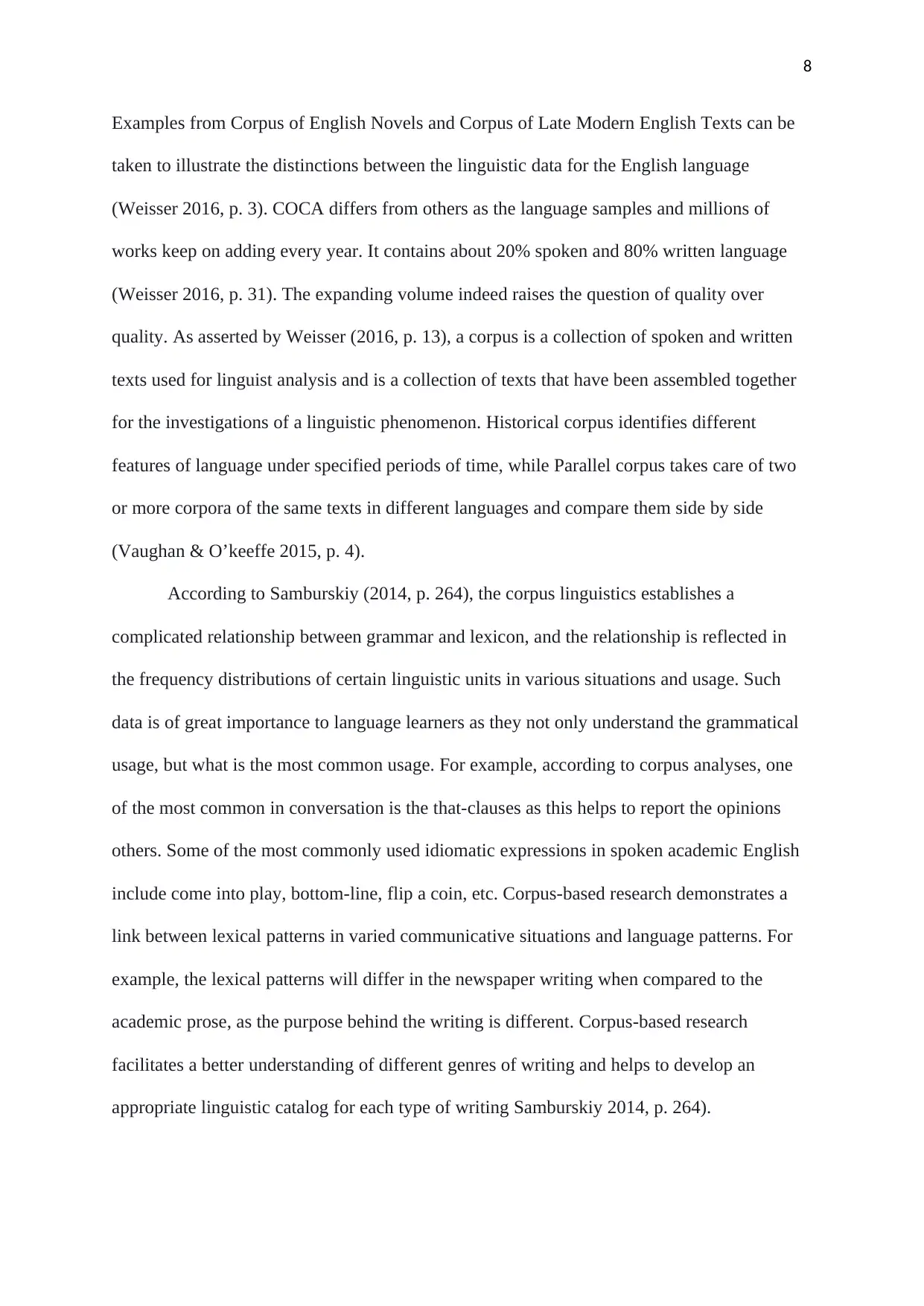
8
Examples from Corpus of English Novels and Corpus of Late Modern English Texts can be
taken to illustrate the distinctions between the linguistic data for the English language
(Weisser 2016, p. 3). COCA differs from others as the language samples and millions of
works keep on adding every year. It contains about 20% spoken and 80% written language
(Weisser 2016, p. 31). The expanding volume indeed raises the question of quality over
quality. As asserted by Weisser (2016, p. 13), a corpus is a collection of spoken and written
texts used for linguist analysis and is a collection of texts that have been assembled together
for the investigations of a linguistic phenomenon. Historical corpus identifies different
features of language under specified periods of time, while Parallel corpus takes care of two
or more corpora of the same texts in different languages and compare them side by side
(Vaughan & O’keeffe 2015, p. 4).
According to Samburskiy (2014, p. 264), the corpus linguistics establishes a
complicated relationship between grammar and lexicon, and the relationship is reflected in
the frequency distributions of certain linguistic units in various situations and usage. Such
data is of great importance to language learners as they not only understand the grammatical
usage, but what is the most common usage. For example, according to corpus analyses, one
of the most common in conversation is the that-clauses as this helps to report the opinions
others. Some of the most commonly used idiomatic expressions in spoken academic English
include come into play, bottom-line, flip a coin, etc. Corpus-based research demonstrates a
link between lexical patterns in varied communicative situations and language patterns. For
example, the lexical patterns will differ in the newspaper writing when compared to the
academic prose, as the purpose behind the writing is different. Corpus-based research
facilitates a better understanding of different genres of writing and helps to develop an
appropriate linguistic catalog for each type of writing Samburskiy 2014, p. 264).
Examples from Corpus of English Novels and Corpus of Late Modern English Texts can be
taken to illustrate the distinctions between the linguistic data for the English language
(Weisser 2016, p. 3). COCA differs from others as the language samples and millions of
works keep on adding every year. It contains about 20% spoken and 80% written language
(Weisser 2016, p. 31). The expanding volume indeed raises the question of quality over
quality. As asserted by Weisser (2016, p. 13), a corpus is a collection of spoken and written
texts used for linguist analysis and is a collection of texts that have been assembled together
for the investigations of a linguistic phenomenon. Historical corpus identifies different
features of language under specified periods of time, while Parallel corpus takes care of two
or more corpora of the same texts in different languages and compare them side by side
(Vaughan & O’keeffe 2015, p. 4).
According to Samburskiy (2014, p. 264), the corpus linguistics establishes a
complicated relationship between grammar and lexicon, and the relationship is reflected in
the frequency distributions of certain linguistic units in various situations and usage. Such
data is of great importance to language learners as they not only understand the grammatical
usage, but what is the most common usage. For example, according to corpus analyses, one
of the most common in conversation is the that-clauses as this helps to report the opinions
others. Some of the most commonly used idiomatic expressions in spoken academic English
include come into play, bottom-line, flip a coin, etc. Corpus-based research demonstrates a
link between lexical patterns in varied communicative situations and language patterns. For
example, the lexical patterns will differ in the newspaper writing when compared to the
academic prose, as the purpose behind the writing is different. Corpus-based research
facilitates a better understanding of different genres of writing and helps to develop an
appropriate linguistic catalog for each type of writing Samburskiy 2014, p. 264).
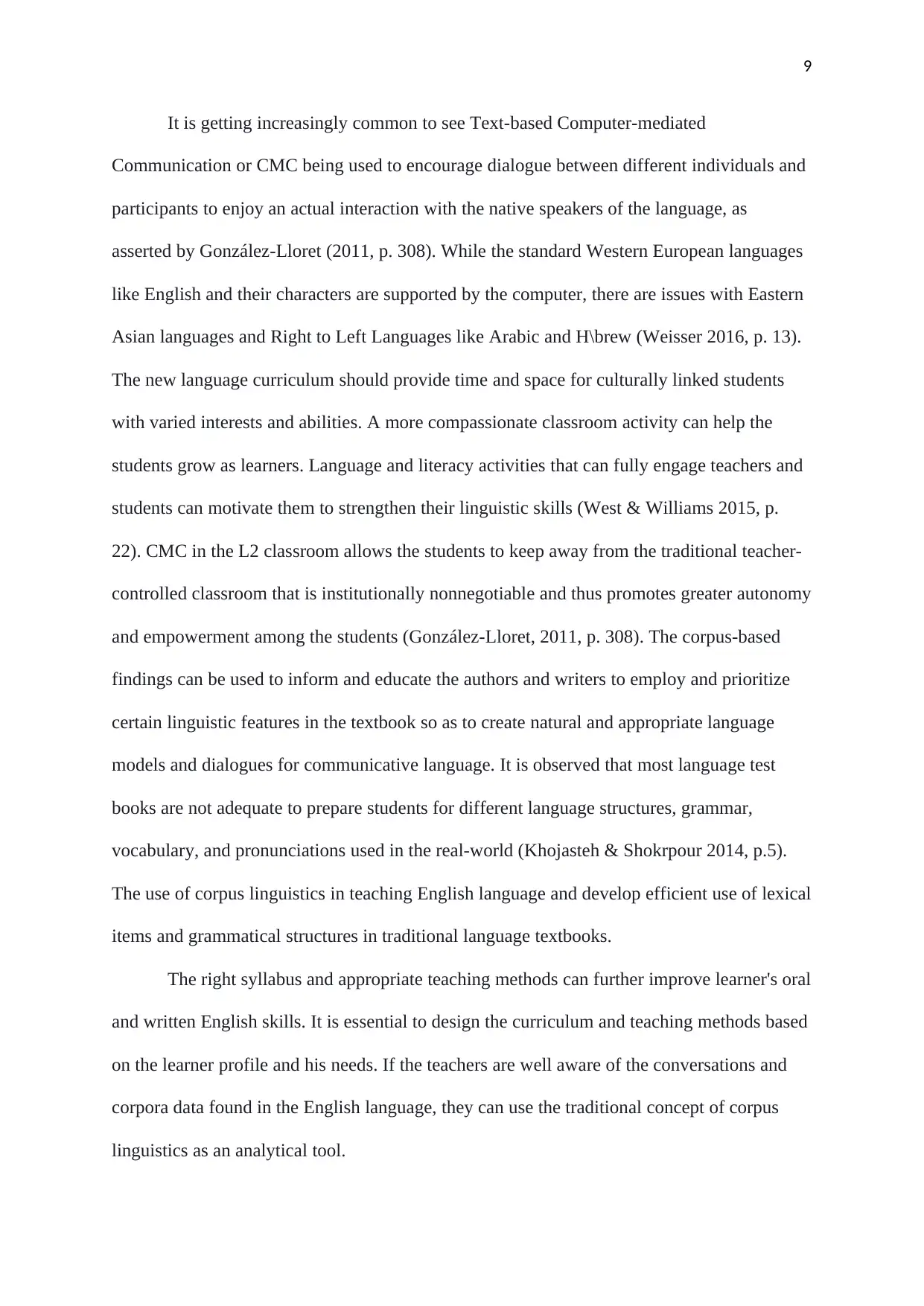
9
It is getting increasingly common to see Text-based Computer-mediated
Communication or CMC being used to encourage dialogue between different individuals and
participants to enjoy an actual interaction with the native speakers of the language, as
asserted by González-Lloret (2011, p. 308). While the standard Western European languages
like English and their characters are supported by the computer, there are issues with Eastern
Asian languages and Right to Left Languages like Arabic and H\brew (Weisser 2016, p. 13).
The new language curriculum should provide time and space for culturally linked students
with varied interests and abilities. A more compassionate classroom activity can help the
students grow as learners. Language and literacy activities that can fully engage teachers and
students can motivate them to strengthen their linguistic skills (West & Williams 2015, p.
22). CMC in the L2 classroom allows the students to keep away from the traditional teacher-
controlled classroom that is institutionally nonnegotiable and thus promotes greater autonomy
and empowerment among the students (González-Lloret, 2011, p. 308). The corpus-based
findings can be used to inform and educate the authors and writers to employ and prioritize
certain linguistic features in the textbook so as to create natural and appropriate language
models and dialogues for communicative language. It is observed that most language test
books are not adequate to prepare students for different language structures, grammar,
vocabulary, and pronunciations used in the real-world (Khojasteh & Shokrpour 2014, p.5).
The use of corpus linguistics in teaching English language and develop efficient use of lexical
items and grammatical structures in traditional language textbooks.
The right syllabus and appropriate teaching methods can further improve learner's oral
and written English skills. It is essential to design the curriculum and teaching methods based
on the learner profile and his needs. If the teachers are well aware of the conversations and
corpora data found in the English language, they can use the traditional concept of corpus
linguistics as an analytical tool.
It is getting increasingly common to see Text-based Computer-mediated
Communication or CMC being used to encourage dialogue between different individuals and
participants to enjoy an actual interaction with the native speakers of the language, as
asserted by González-Lloret (2011, p. 308). While the standard Western European languages
like English and their characters are supported by the computer, there are issues with Eastern
Asian languages and Right to Left Languages like Arabic and H\brew (Weisser 2016, p. 13).
The new language curriculum should provide time and space for culturally linked students
with varied interests and abilities. A more compassionate classroom activity can help the
students grow as learners. Language and literacy activities that can fully engage teachers and
students can motivate them to strengthen their linguistic skills (West & Williams 2015, p.
22). CMC in the L2 classroom allows the students to keep away from the traditional teacher-
controlled classroom that is institutionally nonnegotiable and thus promotes greater autonomy
and empowerment among the students (González-Lloret, 2011, p. 308). The corpus-based
findings can be used to inform and educate the authors and writers to employ and prioritize
certain linguistic features in the textbook so as to create natural and appropriate language
models and dialogues for communicative language. It is observed that most language test
books are not adequate to prepare students for different language structures, grammar,
vocabulary, and pronunciations used in the real-world (Khojasteh & Shokrpour 2014, p.5).
The use of corpus linguistics in teaching English language and develop efficient use of lexical
items and grammatical structures in traditional language textbooks.
The right syllabus and appropriate teaching methods can further improve learner's oral
and written English skills. It is essential to design the curriculum and teaching methods based
on the learner profile and his needs. If the teachers are well aware of the conversations and
corpora data found in the English language, they can use the traditional concept of corpus
linguistics as an analytical tool.
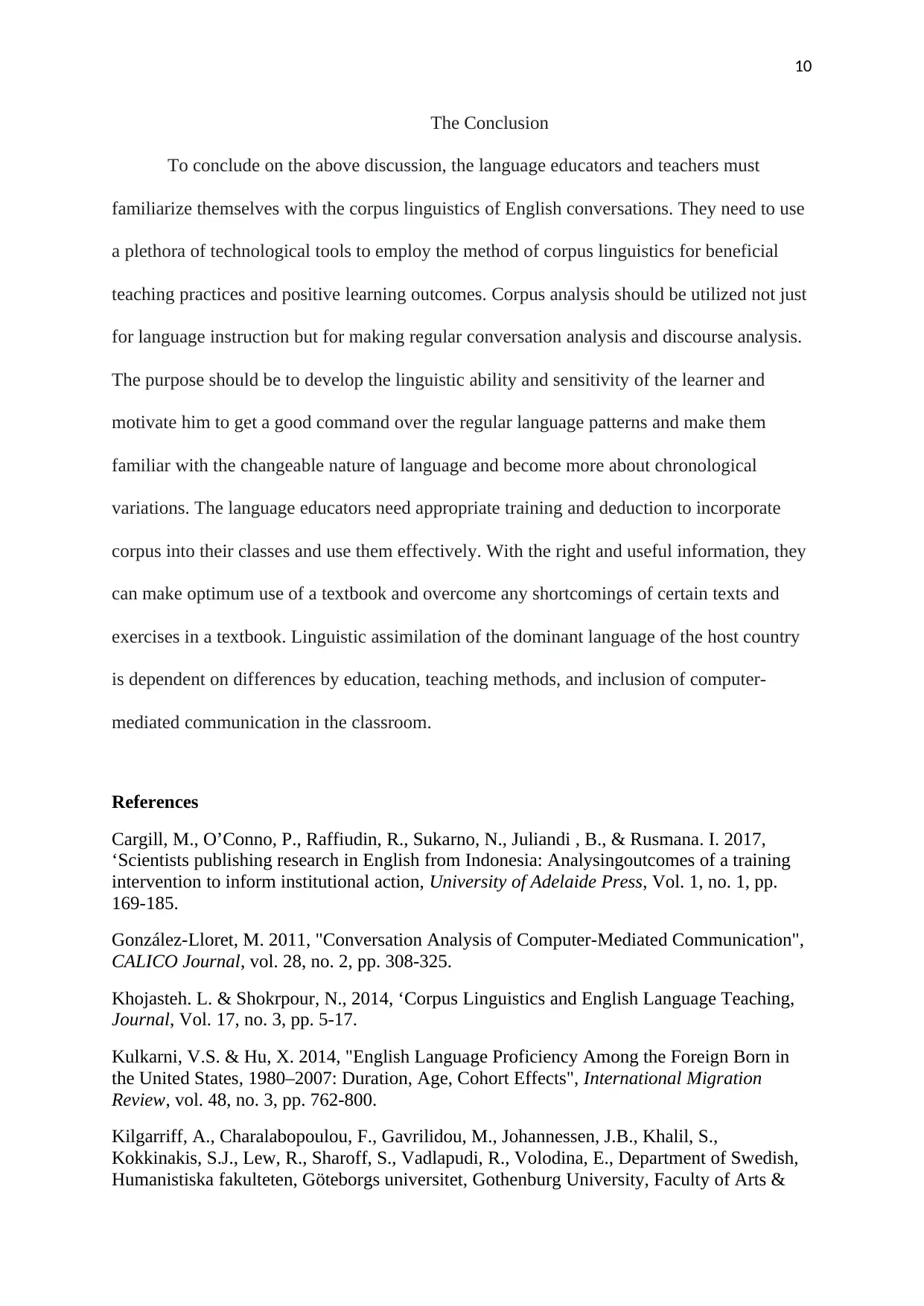
10
The Conclusion
To conclude on the above discussion, the language educators and teachers must
familiarize themselves with the corpus linguistics of English conversations. They need to use
a plethora of technological tools to employ the method of corpus linguistics for beneficial
teaching practices and positive learning outcomes. Corpus analysis should be utilized not just
for language instruction but for making regular conversation analysis and discourse analysis.
The purpose should be to develop the linguistic ability and sensitivity of the learner and
motivate him to get a good command over the regular language patterns and make them
familiar with the changeable nature of language and become more about chronological
variations. The language educators need appropriate training and deduction to incorporate
corpus into their classes and use them effectively. With the right and useful information, they
can make optimum use of a textbook and overcome any shortcomings of certain texts and
exercises in a textbook. Linguistic assimilation of the dominant language of the host country
is dependent on differences by education, teaching methods, and inclusion of computer-
mediated communication in the classroom.
References
Cargill, M., O’Conno, P., Raffiudin, R., Sukarno, N., Juliandi , B., & Rusmana. I. 2017,
‘Scientists publishing research in English from Indonesia: Analysingoutcomes of a training
intervention to inform institutional action, University of Adelaide Press, Vol. 1, no. 1, pp.
169-185.
González-Lloret, M. 2011, "Conversation Analysis of Computer-Mediated Communication",
CALICO Journal, vol. 28, no. 2, pp. 308-325.
Khojasteh. L. & Shokrpour, N., 2014, ‘Corpus Linguistics and English Language Teaching,
Journal, Vol. 17, no. 3, pp. 5-17.
Kulkarni, V.S. & Hu, X. 2014, "English Language Proficiency Among the Foreign Born in
the United States, 1980–2007: Duration, Age, Cohort Effects", International Migration
Review, vol. 48, no. 3, pp. 762-800.
Kilgarriff, A., Charalabopoulou, F., Gavrilidou, M., Johannessen, J.B., Khalil, S.,
Kokkinakis, S.J., Lew, R., Sharoff, S., Vadlapudi, R., Volodina, E., Department of Swedish,
Humanistiska fakulteten, Göteborgs universitet, Gothenburg University, Faculty of Arts &
The Conclusion
To conclude on the above discussion, the language educators and teachers must
familiarize themselves with the corpus linguistics of English conversations. They need to use
a plethora of technological tools to employ the method of corpus linguistics for beneficial
teaching practices and positive learning outcomes. Corpus analysis should be utilized not just
for language instruction but for making regular conversation analysis and discourse analysis.
The purpose should be to develop the linguistic ability and sensitivity of the learner and
motivate him to get a good command over the regular language patterns and make them
familiar with the changeable nature of language and become more about chronological
variations. The language educators need appropriate training and deduction to incorporate
corpus into their classes and use them effectively. With the right and useful information, they
can make optimum use of a textbook and overcome any shortcomings of certain texts and
exercises in a textbook. Linguistic assimilation of the dominant language of the host country
is dependent on differences by education, teaching methods, and inclusion of computer-
mediated communication in the classroom.
References
Cargill, M., O’Conno, P., Raffiudin, R., Sukarno, N., Juliandi , B., & Rusmana. I. 2017,
‘Scientists publishing research in English from Indonesia: Analysingoutcomes of a training
intervention to inform institutional action, University of Adelaide Press, Vol. 1, no. 1, pp.
169-185.
González-Lloret, M. 2011, "Conversation Analysis of Computer-Mediated Communication",
CALICO Journal, vol. 28, no. 2, pp. 308-325.
Khojasteh. L. & Shokrpour, N., 2014, ‘Corpus Linguistics and English Language Teaching,
Journal, Vol. 17, no. 3, pp. 5-17.
Kulkarni, V.S. & Hu, X. 2014, "English Language Proficiency Among the Foreign Born in
the United States, 1980–2007: Duration, Age, Cohort Effects", International Migration
Review, vol. 48, no. 3, pp. 762-800.
Kilgarriff, A., Charalabopoulou, F., Gavrilidou, M., Johannessen, J.B., Khalil, S.,
Kokkinakis, S.J., Lew, R., Sharoff, S., Vadlapudi, R., Volodina, E., Department of Swedish,
Humanistiska fakulteten, Göteborgs universitet, Gothenburg University, Faculty of Arts &
Secure Best Marks with AI Grader
Need help grading? Try our AI Grader for instant feedback on your assignments.
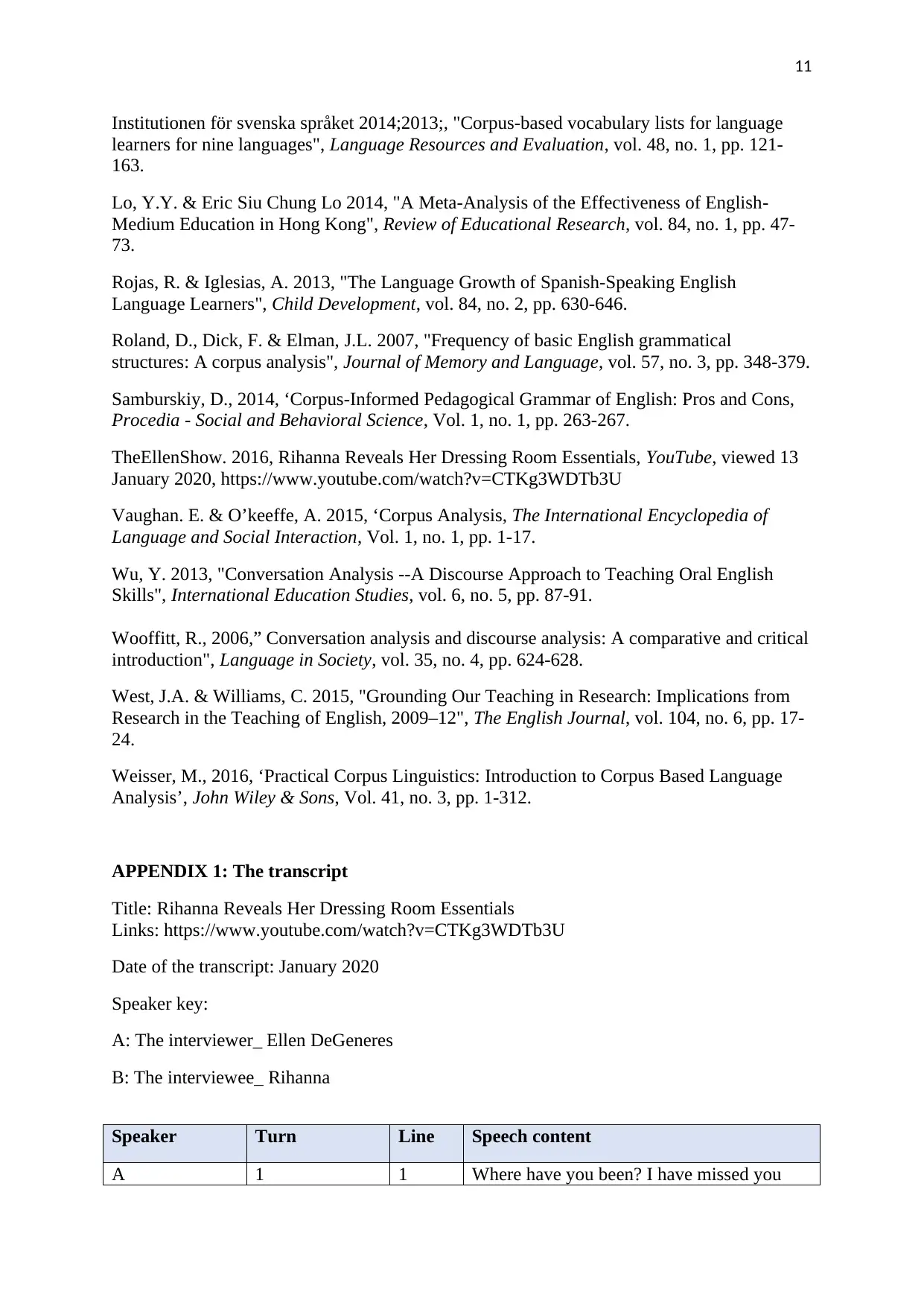
11
Institutionen för svenska språket 2014;2013;, "Corpus-based vocabulary lists for language
learners for nine languages", Language Resources and Evaluation, vol. 48, no. 1, pp. 121-
163.
Lo, Y.Y. & Eric Siu Chung Lo 2014, "A Meta-Analysis of the Effectiveness of English-
Medium Education in Hong Kong", Review of Educational Research, vol. 84, no. 1, pp. 47-
73.
Rojas, R. & Iglesias, A. 2013, "The Language Growth of Spanish-Speaking English
Language Learners", Child Development, vol. 84, no. 2, pp. 630-646.
Roland, D., Dick, F. & Elman, J.L. 2007, "Frequency of basic English grammatical
structures: A corpus analysis", Journal of Memory and Language, vol. 57, no. 3, pp. 348-379.
Samburskiy, D., 2014, ‘Corpus-Informed Pedagogical Grammar of English: Pros and Cons,
Procedia - Social and Behavioral Science, Vol. 1, no. 1, pp. 263-267.
TheEllenShow. 2016, Rihanna Reveals Her Dressing Room Essentials, YouTube, viewed 13
January 2020, https://www.youtube.com/watch?v=CTKg3WDTb3U
Vaughan. E. & O’keeffe, A. 2015, ‘Corpus Analysis, The International Encyclopedia of
Language and Social Interaction, Vol. 1, no. 1, pp. 1-17.
Wu, Y. 2013, "Conversation Analysis --A Discourse Approach to Teaching Oral English
Skills", International Education Studies, vol. 6, no. 5, pp. 87-91.
Wooffitt, R., 2006,” Conversation analysis and discourse analysis: A comparative and critical
introduction", Language in Society, vol. 35, no. 4, pp. 624-628.
West, J.A. & Williams, C. 2015, "Grounding Our Teaching in Research: Implications from
Research in the Teaching of English, 2009–12", The English Journal, vol. 104, no. 6, pp. 17-
24.
Weisser, M., 2016, ‘Practical Corpus Linguistics: Introduction to Corpus Based Language
Analysis’, John Wiley & Sons, Vol. 41, no. 3, pp. 1-312.
APPENDIX 1: The transcript
Title: Rihanna Reveals Her Dressing Room Essentials
Links: https://www.youtube.com/watch?v=CTKg3WDTb3U
Date of the transcript: January 2020
Speaker key:
A: The interviewer_ Ellen DeGeneres
B: The interviewee_ Rihanna
Speaker Turn Line Speech content
A 1 1 Where have you been? I have missed you
Institutionen för svenska språket 2014;2013;, "Corpus-based vocabulary lists for language
learners for nine languages", Language Resources and Evaluation, vol. 48, no. 1, pp. 121-
163.
Lo, Y.Y. & Eric Siu Chung Lo 2014, "A Meta-Analysis of the Effectiveness of English-
Medium Education in Hong Kong", Review of Educational Research, vol. 84, no. 1, pp. 47-
73.
Rojas, R. & Iglesias, A. 2013, "The Language Growth of Spanish-Speaking English
Language Learners", Child Development, vol. 84, no. 2, pp. 630-646.
Roland, D., Dick, F. & Elman, J.L. 2007, "Frequency of basic English grammatical
structures: A corpus analysis", Journal of Memory and Language, vol. 57, no. 3, pp. 348-379.
Samburskiy, D., 2014, ‘Corpus-Informed Pedagogical Grammar of English: Pros and Cons,
Procedia - Social and Behavioral Science, Vol. 1, no. 1, pp. 263-267.
TheEllenShow. 2016, Rihanna Reveals Her Dressing Room Essentials, YouTube, viewed 13
January 2020, https://www.youtube.com/watch?v=CTKg3WDTb3U
Vaughan. E. & O’keeffe, A. 2015, ‘Corpus Analysis, The International Encyclopedia of
Language and Social Interaction, Vol. 1, no. 1, pp. 1-17.
Wu, Y. 2013, "Conversation Analysis --A Discourse Approach to Teaching Oral English
Skills", International Education Studies, vol. 6, no. 5, pp. 87-91.
Wooffitt, R., 2006,” Conversation analysis and discourse analysis: A comparative and critical
introduction", Language in Society, vol. 35, no. 4, pp. 624-628.
West, J.A. & Williams, C. 2015, "Grounding Our Teaching in Research: Implications from
Research in the Teaching of English, 2009–12", The English Journal, vol. 104, no. 6, pp. 17-
24.
Weisser, M., 2016, ‘Practical Corpus Linguistics: Introduction to Corpus Based Language
Analysis’, John Wiley & Sons, Vol. 41, no. 3, pp. 1-312.
APPENDIX 1: The transcript
Title: Rihanna Reveals Her Dressing Room Essentials
Links: https://www.youtube.com/watch?v=CTKg3WDTb3U
Date of the transcript: January 2020
Speaker key:
A: The interviewer_ Ellen DeGeneres
B: The interviewee_ Rihanna
Speaker Turn Line Speech content
A 1 1 Where have you been? I have missed you
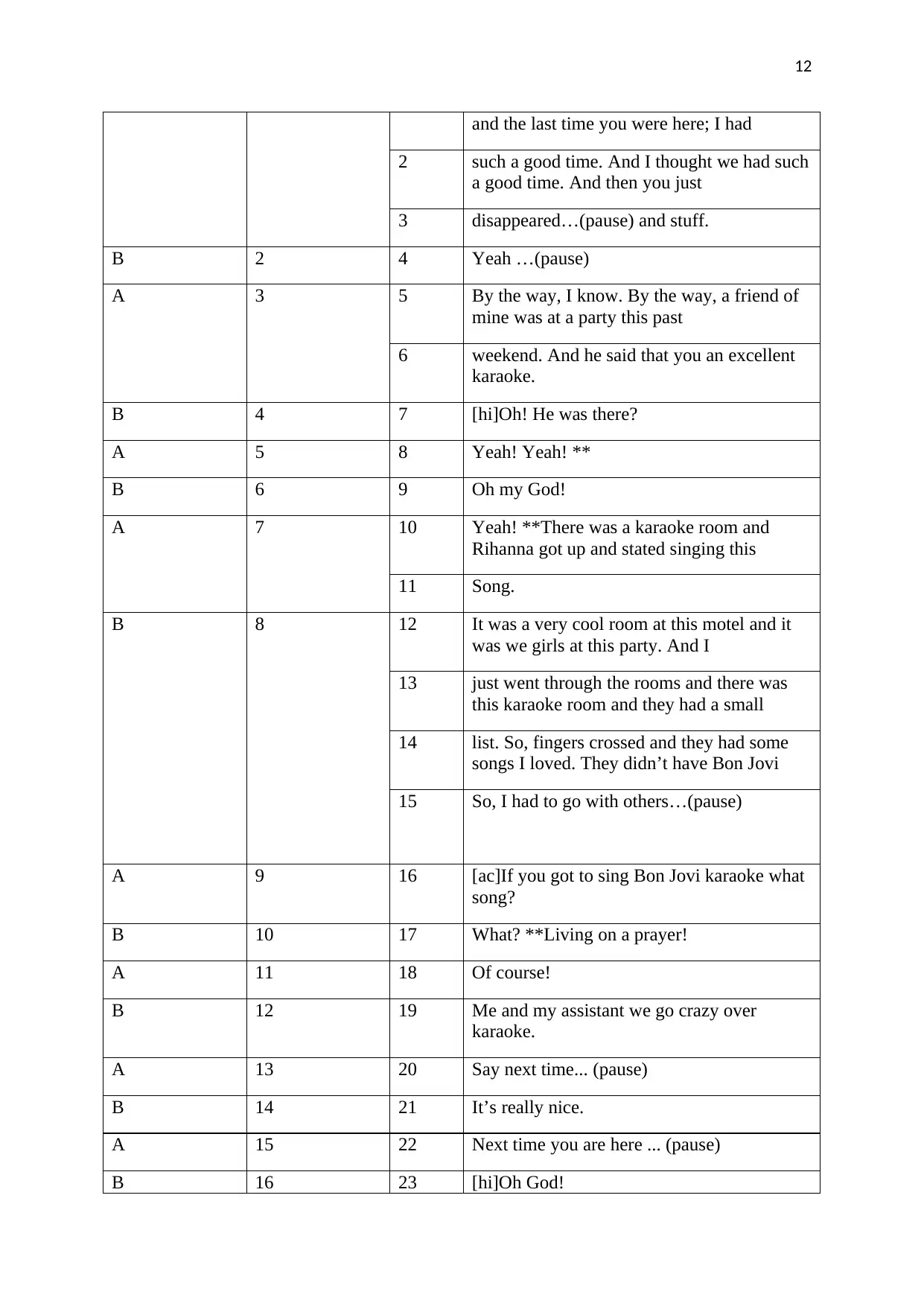
12
and the last time you were here; I had
2 such a good time. And I thought we had such
a good time. And then you just
3 disappeared…(pause) and stuff.
B 2 4 Yeah …(pause)
A 3 5 By the way, I know. By the way, a friend of
mine was at a party this past
6 weekend. And he said that you an excellent
karaoke.
B 4 7 [hi]Oh! He was there?
A 5 8 Yeah! Yeah! **
B 6 9 Oh my God!
A 7 10 Yeah! **There was a karaoke room and
Rihanna got up and stated singing this
11 Song.
B 8 12 It was a very cool room at this motel and it
was we girls at this party. And I
13 just went through the rooms and there was
this karaoke room and they had a small
14 list. So, fingers crossed and they had some
songs I loved. They didn’t have Bon Jovi
15 So, I had to go with others…(pause)
A 9 16 [ac]If you got to sing Bon Jovi karaoke what
song?
B 10 17 What? **Living on a prayer!
A 11 18 Of course!
B 12 19 Me and my assistant we go crazy over
karaoke.
A 13 20 Say next time... (pause)
B 14 21 It’s really nice.
A 15 22 Next time you are here ... (pause)
B 16 23 [hi]Oh God!
and the last time you were here; I had
2 such a good time. And I thought we had such
a good time. And then you just
3 disappeared…(pause) and stuff.
B 2 4 Yeah …(pause)
A 3 5 By the way, I know. By the way, a friend of
mine was at a party this past
6 weekend. And he said that you an excellent
karaoke.
B 4 7 [hi]Oh! He was there?
A 5 8 Yeah! Yeah! **
B 6 9 Oh my God!
A 7 10 Yeah! **There was a karaoke room and
Rihanna got up and stated singing this
11 Song.
B 8 12 It was a very cool room at this motel and it
was we girls at this party. And I
13 just went through the rooms and there was
this karaoke room and they had a small
14 list. So, fingers crossed and they had some
songs I loved. They didn’t have Bon Jovi
15 So, I had to go with others…(pause)
A 9 16 [ac]If you got to sing Bon Jovi karaoke what
song?
B 10 17 What? **Living on a prayer!
A 11 18 Of course!
B 12 19 Me and my assistant we go crazy over
karaoke.
A 13 20 Say next time... (pause)
B 14 21 It’s really nice.
A 15 22 Next time you are here ... (pause)
B 16 23 [hi]Oh God!
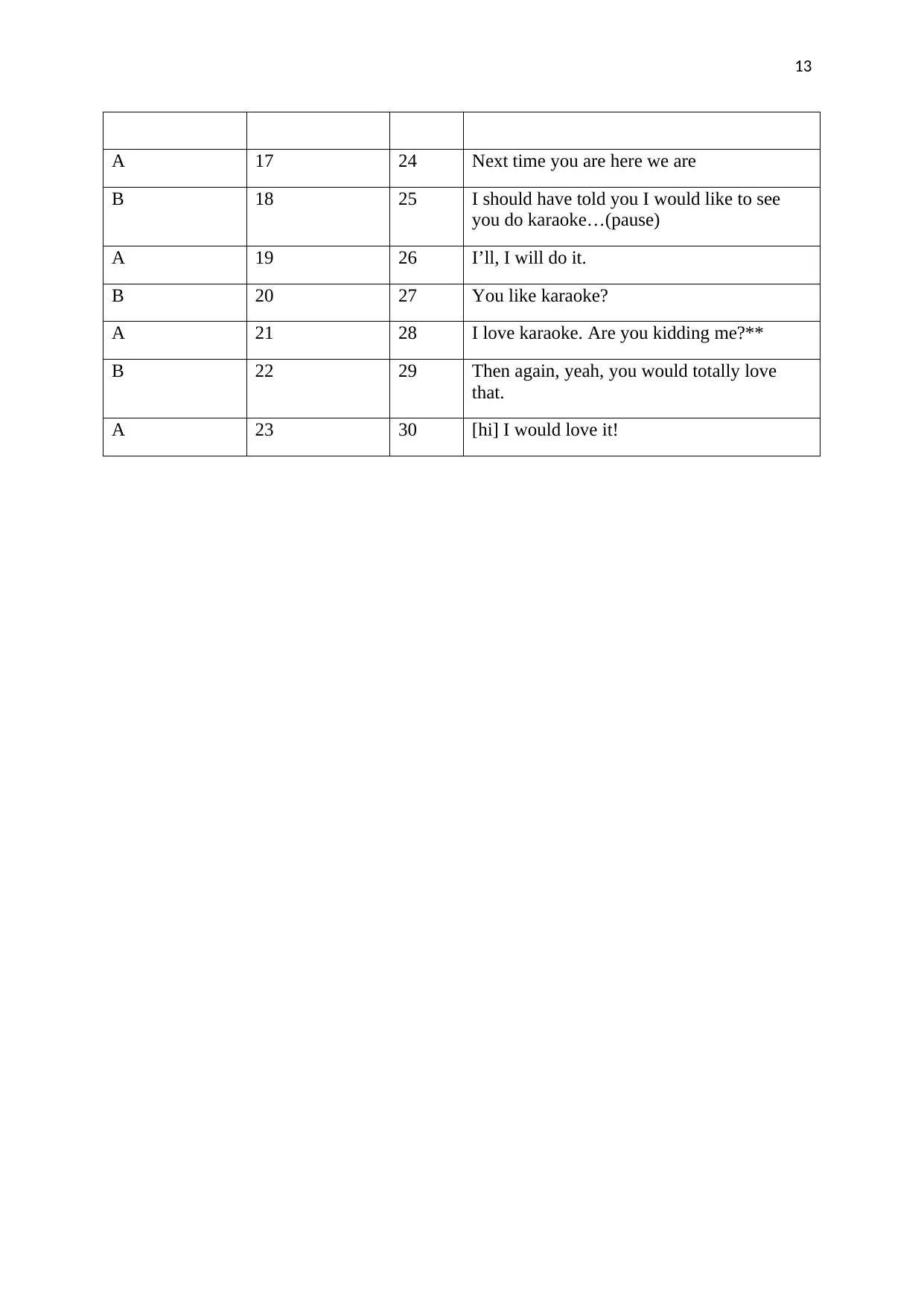
13
A 17 24 Next time you are here we are
B 18 25 I should have told you I would like to see
you do karaoke…(pause)
A 19 26 I’ll, I will do it.
B 20 27 You like karaoke?
A 21 28 I love karaoke. Are you kidding me?**
B 22 29 Then again, yeah, you would totally love
that.
A 23 30 [hi] I would love it!
A 17 24 Next time you are here we are
B 18 25 I should have told you I would like to see
you do karaoke…(pause)
A 19 26 I’ll, I will do it.
B 20 27 You like karaoke?
A 21 28 I love karaoke. Are you kidding me?**
B 22 29 Then again, yeah, you would totally love
that.
A 23 30 [hi] I would love it!
1 out of 13
Your All-in-One AI-Powered Toolkit for Academic Success.
+13062052269
info@desklib.com
Available 24*7 on WhatsApp / Email
![[object Object]](/_next/static/media/star-bottom.7253800d.svg)
Unlock your academic potential
© 2024 | Zucol Services PVT LTD | All rights reserved.
